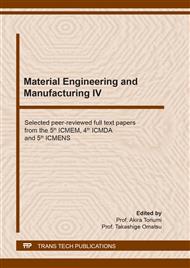p.3
p.9
p.15
p.21
p.26
p.35
p.45
p.52
Investigation on the Performance of Al7075 Alloy Surface Repaired by Cold Spray Coating Technology
Abstract:
Repairing different waste parts is an attractive issue due to the cost of repaired parts is much lower than the cost produced by conventional methods. In this study, the Al7075 aluminium alloy surface was repaired using the Ni-Zn-Al2O3 powder by the cold spray coating method. The microstructure, micro-hardness, and tribological performance of the repaired zone were determined. The microstructure of repaired zone consisted of ceramic Al2O3 particles embedded in the Ni and Zn metal matrix, similar to a lamellar structure. The average microhardness value of the repaired area was about 4.3% higher than the Al7075 substrate. Although the average coefficient of friction had increased in the repaired area, the wear rate had decreased approximately 1.3 times. As a result of the FESEM examination of the wear channels, the main wear mechanism of the Al7075 material was abrasive, while the main wear mechanism of the sample repaired with cold spray coating was determined as adhesive wear. Consequently, it increases the service life of the part, as the repaired zone with cold spray coating shows approximately 1.3 times better wear performance than Al7075.
Info:
Periodical:
Pages:
9-14
Citation:
Online since:
September 2021
Authors:
Keywords:
Price:
Сopyright:
© 2021 Trans Tech Publications Ltd. All Rights Reserved
Share:
Citation:


